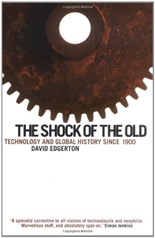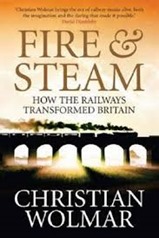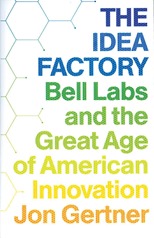Author's posts
Jul 29 2014
Book review: The Shock of the Old by David Edgerton
 The Shock of the Old by David Edgerton is a history of technology in the 20th century.
The Shock of the Old by David Edgerton is a history of technology in the 20th century.
A central motivation of the book is that, according to the author, other histories of technology are wrong in that they focus overly on the dates and places of invention and pay little attention to the subsequent dissemination and use of technologies.
The book is divided thematically covering significance, time, production, maintenance, nations, war, killing and invention. Significance reports on the quantitative, economic significance of a technology, something on which there is surprisingly little data.
A recurring theme is the persistence of things we might consider to have been replaced by new technology, the horse, for example. It’s perhaps not surprising that a huge number of horses were used during the First World War but the German’s, the masters of the mechanised blitzkrieg, used 625,000 horses in 1941 when they invaded the Soviet Union. This isn’t the end of the story of animal power: Cuba, as a result of sanctions and the fall of the Soviet Union was using nearly 400,000 oxen by the end of the 1990s.
The same goes for battleships and military aircraft. When Britain and Argentina fought over the Falkland Islands in 1982, the Belgrano, originally commissioned into the US Navy in 1939 was sunk by 21-inch MK8 torpedoes originally designed in 1927! The Falklands airstrips were bombed from Britain by Vulcan bombers refuelled by Victor in-flight tankers, originally built in the 1950s. The reason for this is that the persistent technology actually does it’s job pretty well, the cost of replacing it for marginal benefit is too high and maintenance and repair means that to a degree these technological artefacts have been almost entirely rebuilt.
The time chapter expands on the idea that the introduction of technologies to different places is not simply a case of timeshifting, it depends on the local context. We find, for example, that horse draw carts are constructed from the parts of cars. And that corrugated iron and asbestos-cement are the material of choice for construction in the new slums of the developing world. Edgerton refers to these as ‘creole’ technologies – old technologies which have been repurposed into a new life.
In terms of technology and economic growth, it has really been mass production which has lead directly and obviously to economic growth particularly in the 30 years after the Second World War, known as the ‘long boom’. And whilst there was a boom in new technologies, all around the world the oldest technology – agriculture was also experiencing a boom in productivity – overshadowed by the new things.
As usual with such a book I picked up some useful facts to deploy at the dinner table:
- The German V-2 rocket killed more people in its production than it did in its use.
- The inventor of the Aga cooking range was a Nobel prize winning physicist.
For a scientist this book makes for an uncomfortable read in places since we come to the topic with some preconceived ideas and position, which are not necessarily grounded in the best of historical methods. For instance, Edgerton highlights that R&D spend just doesn’t correlate with economic growth. And that to a large degree the nation of invention is not the nation which benefits from an invention.
Perhaps most damning in the eyes of scientists, their bête noire, Simon Jenkins has supplied a cover quote:
The Shock of the Old is a book I can use. I can take it in two hands and bash it over the heads of every techno-nerd, computer geek and neophiliac futurologist I meet!
It’s a mistake to think of all scientists and computer geeks as being neophiliac. One of my colleagues works using an IBM Model M keyboard which we recently established was older than our intern, he also prefers the VIM editor – based on technology born in the 1970s. In the laboratory, the favoured computer language for scientific computation is still often FORTRAN, invented in the 1950s.
Thinking back over the other books I’ve read on the history of technology, for example A Computer Called LEO, Fire & Steam, The Subterranean Railway, Empire of the Clouds, The Idea Factory and The Backroom Boys. It is true to say they have very much focussed on single technologies or places but to my mind they have generally been pragmatic about the impact on society of their chosen subject. The authors have each had a definite passion for their topic leading to regret for what might have been: a thriving British aircraft industry, computer industry and so forth. But they don’t seem to provide the litany of dates and inventions of which Edgerton accuses them.
Despite this The Shock of the Old is readable, the author knows his field and provides a different viewpoint on the history of technology, more overarching, not so besotted. I’ll certainly be looking out for more of his books.
Jul 20 2014
Book review: Half a wife by Gaby Hinsliff
 Half a Wife: The Working Family’s Guide to Getting a Life Back by Gaby Hinsliff, is a proposal as to how families can live their lives.
Half a Wife: The Working Family’s Guide to Getting a Life Back by Gaby Hinsliff, is a proposal as to how families can live their lives.
The title sacrifices clarity for a catchy headline. The “half a wife” is a reference to the fraction of her time Hinsliff wanted to be a full-time mother, or rather the collective target that she, and her husband would aim to achieve. Mrs SomeBeans and I have accidently hit this target – I work full time, Mrs SomeBeans works 2.5 days per week.
As a society we’ve moved away from the traditional family of a full-time employed (male) breadwinner and a full-time (female) housewife. This model used to be enforced firmly. In the early 1970s, when she fell pregnant with me, there was no question my mother would leave her job and wouldn’t be coming back. In fact when my brother and I were small, a local garage refused to give her a job application form because she had children. My mothers experience was not unusual. But by 1983 two thirds of mothers stayed at home to bring up their children, by 2010 only one third were doing so.
This shift is a result of a societal change with a macroeconomic benefit – more workers make a more productive economy. It has been facilitated and encouraged by government policy.
Half a wife addresses how we might cope with this change. It is written from the point of view of someone getting a “London premium” by moving out of London, whose reduced income just goes over the line into the upper rate of tax and who seems pretty talented. Things not available to all of us.
The book is based around interviews with a range of parents, focussed on how people organise their family life. This is rather useful since I suspect we are largely unaware of other people’s domestic arrangements, what might be possible. At times I felt Hinsliff must have been spying on us, so many things rang so true – the tensions over household chores, the boredom and frustrations of child rearing, the added stress of travelling for work with a child at home. I’d have welcomed an appendix collecting each of these stories, since as it stands they are scattered in fragments through the book.
I worked 4 days a week for a while, when Mrs SomeBeans was still on maternity leave. This was a cosy arrangement but when she returned to work and I looked after Thomas by myself for one day a week – I got bored. I feel ashamed to say it but it seems from Hinsliff’s book that I’m not alone. Financially, working an extra day a week didn’t make a great deal of difference. What I gained in salary I pretty much lost in nursery charges, and would have gone completely if we’d have taken on a cleaner. This does fit with a theme of the book, people – both men and women, value working life. So even if going to work is no better than cost neutral, many people will chose to work.
Hinsliff’s proposal for family life is the “half a wife” solution, a midway point between the traditional breadwinner/homemaker and two full-time employed model. The path to this proposal is not direct, it’s a combination of career, housing, childcare and schooling. A recurring theme of the book is that the family policy to support this proposal is not just for women. I like this sentiment.
The career side of the problem is covered by the “z-shaped trajectory”, with the horizontals representing those times when family takes over and the career goes on hold and the diagonals when things take off. I have to say this seems terribly well organised! My career has suffered from a lack of a master plan. My earliest guide was my dad, who worked for the same organisation for his entire working life. I had a spell working on short term contracts in academia before gaining tenure, then gave it all up to work for Unilever for a period. Most recently I joined a startup in Liverpool, it’s only with this most recent move that I’ve started to appreciate that I’ve got marketable skills. The policy support here is in pushing companies to allow more flexible working, for both women and men.
Housing forms another part of the jigsaw puzzle, housing costs in the UK are high, particularly where there are jobs. Long commutes to work are both bad in themselves for employee happiness, and damaging for family life. Housing is a difficult bullet to bite there is a tacit agreement that house prices are too high. But bringing them down means a large block of voters will lose out.
Childcare is a second leg of the problem, I must admit I look with envy on other couples mentioned in the book who get support from conveniently located family. Schooling has some part to play here, for working families a school day shorter than a working day presents a childcare challenge. Even worse, the long summer holidays, originally designed to support the use of children as an agricultural labour force.
Half a wife helps answer the question: “how do I be a grown-up?” for which I’ve never felt well-prepared. Doubly so when it came to fatherhood and how it fitted with work, and my previous life. It’s well researched and readable. I wish I’d read it before I entered adult life!
Jun 24 2014
Book review: Fire & Steam by Christian Wolmar
 I’ve long been a bit of a train enthusiast, reflected in my reading of biographies of Brunel and Stephenson, and more recently Christian Wolmar’s The Subterranean Railway about the London Underground. This last one is my inspiration for reading Wolmar’s Fire & Steam: How the railways transformed Britain which is a more general history of railways in Britain.
I’ve long been a bit of a train enthusiast, reflected in my reading of biographies of Brunel and Stephenson, and more recently Christian Wolmar’s The Subterranean Railway about the London Underground. This last one is my inspiration for reading Wolmar’s Fire & Steam: How the railways transformed Britain which is a more general history of railways in Britain.
Fire & Steam follows the arc of the development of the railways from the the earliest signs: the development of railed ways to carry minerals from mine to water, with carriages powered by horses or men.
The railways appeared at a happy confluence of partly developed technologies. In the later half of the 18th century the turnpike road system and canal systems were taking shape but were both limited in their capabilities. However, they demonstrated the feasibility of large civil engineering projects. Steam engines were becoming commonplace but were too heavy and cumbersome for the road system and the associated technologies: steering, braking, suspension and so forth were not yet ready. From a financial point of view, the railways were the first organisations to benefit from limited liability partnerships of more than six partners.
Wolmar starts his main story with the Liverpool & Manchester (L&M) line, completed in 1830, arguing that the earlier Stockton & Darlington line (1825) was not the real deal. It was much in the spirit of the earlier mine railways and passenger transport was a surprising success. The L&M was a twin-track line between two large urban centres, with trains pulled by steam engines. Although it was intended as a freight route passenger transport was built in from the start.
After a period of slow growth, limited by politics and economics, the 1840s saw an explosion in the growth of the railway system. The scale of this growth was staggering. In 1845 240 bills were put to parliament representing approximately £100million of work, at the time this was 150% of Gross National Product (GNP). Currently GNP is approximately £400billion, and HS2 is expected to cost approximately £43billion – so about 10% of GNP. Wolmar reports the opposition to the original London & Birmingham line in 1832, it sounds quite familiar. Opposition came from several directions, some from the owners of canals and turnpike roads, some from landowners unwilling to give up any of their land, some from opportunists.
The railways utterly changed life in Britain. At the beginning of the century travel beyond your neighbouring villages was hard but by the time of the Great Exhibition in 1851, a third of the population was able to get themselves to London, mostly by train. This was simply a part of the excursion culture, trains had been whizzing people off to the seaside, the races, and other events in great numbers from almost the beginning of the railway network. No longer were cows kept in central London in order to ensure a supply of fresh milk
In the 19th century, financing and building railways was left to private enterprise. The government’s role was in approving new schemes, controlling fares and conditions of carriage, and largely preventing amalgamations. There was no guiding mind at work designing the rail network. Companies built what they could and competed with their neighbours. This led to a network which was in some senses excessive, giving multiple routes between population centres but this gave it resilience.
The construction of the core network took the remainder of the 19th century, no major routes were built in the 20th century and we have only seen HS1, the fast line running from London to Dover completed in this century.
The 20th century saw the decline of the railways, commencing after the First World War when the motor car and the lorry started to take over, relatively uninhibited by regulation and benefitting from state funding for infrastructure. The railways were requisitioned for war use during both world wars, and were hard used by it – suffering a great deal of wear and tear for relatively little compensation. War seems also to have given governments a taste for control, after the First World War the government forced a rationalisation of the many railway companies to the “Big Four”. After the Second World War the railway was fully nationalised. For much of the next 25 years it suffered considerable decline, a combination of a lack of investment, a reluctance to move away from steam power to much cheaper diesel and electric propulsion, culminating in the Beeching “rationalisation” of the network in the 1960s.
The railways picked up during the latter half of the seventies with electrification, new high speed trains and the InterCity branding. Wolmar finishes with the rail privatisation of the late 1990s, of which he has a rather negative view.
Fire & Steam feels a more well-rounded book than Subterranean Railway which to my mind became a somewhat claustrophobic litany of lines and stations in places. Fire & Steam focuses on the bigger picture and there is grander sweep to it.
Jun 18 2014
Book Review: The Idea Factory by Jon Gertner

I’ve read about technology and innovation in post-war Britain, in the form of Empire of the Clouds, A Computer called Leo and Backroom Boys. Now I turn to American technology, in the form of The Idea Factory: Bell Labs and the Great Age of American Innovation by Jon Gertner.
Bell Laboratories was the research and development arm of the American Telephone and Telegraph Company (AT&T) which held a monopoly position in the US telephone market for over half a century. Bell Labs still exists today as a subsidiary of Alcatel-Lucent but it is much reduced from its former glory.
What did they invent at Bell Laboratories?
An embarrassment of things: the transistor, the charge-couple device, photovoltaic solar cells, the UNIX operating system, C and C++ programming languages. And they also discovered the cosmic microwave background. They were the main contractor for some of the earliest passive and active communications satellites and the earliest cell phone systems. Claude Shannon worked at Bell Laboratories where he published his paper on information theory, in computing Shannon is pretty much the equal of Turing in terms of influence on the field. If statistics is more your thing, then John Tukey is a Bell Labs alumnus.
This is a seriously impressive track record: Bell Laboratories boast 7 Nobel prizes for work done at the laboratory. To get an idea of the scale of this achievement the equivalent figure for Cambridge University is 17, Oxford University 8 and MIT 18. IBM has 5. See for yourself here.
I was semi-aware of all of these inventions but hadn’t really absorbed that they were all from Bell Labs.
For something over 50 years Bell Laboratories benefitted from a state-mandated monopoly which only came to an end in the mid-eighties. They had argued in the 1920s that they needed a monopoly to build the required infrastructure to connect a (large) nation. In the early days that infrastructure was a system of wires and poles, spanning the country, then cables crossing the ocean, then automatic telephone exchanges first valve based then solid-state. They developed a habit of in depth research, in the early days into improving the longevity of telegraph poles, and the leather belts of line engineers, moving on to solid-state physics after the war. In exchange for their monopoly they were restricted in the areas of business they could enter and obliged to license their patents on generous terms.
It’s interesting to compare the development of the vacuum tube as an electronic device with that of the transistor. In both cases the early versions were temperamental, expensive and bulky but through a process of development over many years they became commodity devices. Bell pushed ahead with the development of the solid-state transistor with their optimisation of vacuum tubes as a guide to what was possible.
During the Second World War, Bell Laboratories and its staff were heavily involved in the war effort. In particular the development of radar, which to my surprise was a programme 50% larger than the Manhattan Project in cost terms. Bell Laboratories most expensive project was the first electronic switching station, first deployed in 1964. This is a company that strung cables across continents and oceans, launched satellites and the most expensive thing it ever did was build a blockhouse full of electronics!
Ultimately the AT&T monopoly gave it huge and assured revenue for a long period, relatively free of government interference. The money flowed from captive telephone customers, not the government and the only requirement from AT&T’s point of view was to ensure government did not break its monopoly. In the UK the fledgling computer industry suffered from a lack of a large “home” market. Whilst the aircraft industry suffered from having an unreliable main market in the form of the UK government.
Despite my review which I see makes almost no mention of the people, The Idea Factory is written around people, both the managers and the scientists on the ground. Bell Labs was successful because of the quality of the people it attracted, it sought them out through a personal network spanning the universities of the US. It kept them because they saw they could work in a stimulating and well-funded environment which tolerated sometimes odd behaviour.
It does bring to mind the central research laboratories of some of the UK’s major companies with which I am familiar, including ICI, Unilever and Courtaulds. Of these only Unilever’s survives, and in much reduced form.
The Idea Factory is well-written and engaging, telling an interesting story. It lacks context in what was going on outside Bell Laboratories but then this is not an area it claims to cover.
May 29 2014
Book review: Learning SPARQL by Bob DuCharme
This review was first published at ScraperWiki.
The NewsReader project on which we are working at ScraperWiki uses semantic web technology and natural language processing to derive meaning from the news. We are building a simple API to give access to the NewsReader datastore, whose native interface is SPARQL. SPARQL is a SQL-like query language used to access data stored in the Resource Description Framework format (RDF).
I reach Bob DuCharme’s book, Learning SPARQL, through an idle tweet mentioning SPARQL, to which his book account replied. The book covers the fundamentals of the semantic web and linked data, the RDF standard, the SPARQL query language, performance, and building applications on SPARQL. It also talks about ontologies and inferencing which are built on top of RDF.
As someone with a slight background in SQL and table-based databases, my previous forays into the semantic web have been fraught since I typically start by asking what the schema for an RDF store is. The answer to this question is “That’s the wrong question”. The triplestore is the basis of all RDF applications, as the name implies each row contains a triple (i.e. three columns) which are traditionally labelled subject, predicate and object. I found it easier to think in terms of resource, property name and property value. To give a concrete example “David Beckham” is an example of a resource, his height is the name of a property of David Beckham and, according to dbpedia, the value of this property is 1.8288 (metres, we must assume). The resource and property names must be provided in the from of URIs (unique resource identifiers) the property value can be a URI or some normally typed entity such as a string or an integer.
The triples describe a network of nodes (the resource and property values) with property names being the links between them, with this infrastructure any network can be described by a set of triples. SPARQL is a query language that superficially looks much like SQL. It can extract arbitrary sets of properties from the network using the SELECT command, get a valid sub-network described by a set of triples using the CONSTRUCT command, answer a question with a Yes/No answer using the ASK command. And it can tell you “everything” it knows about a particular URI using the DESCRIBE command, where “everything” is subject to the whim of the implementor. It also supports a bunch of other commands which feel familiar to SQListas such as LIMIT, OFFSET, FROM, WHERE, UNION, ORDER BY, GROUP BY, and AS. In addition there are the commands BIND which allows the transformation of variables by functions and VALUES which allows you to make little data structures for use within queries. PREFIX provides shortcuts to domains of URIs, for example http://dbpedia.org/resource/David_Beckham can be written dbpedia:David_Beckham, where dbpedia: is the prefix. SERVICE allows you to make queries across the internet to other SPARQL providers. OPTIONAL allows the addition of a variable which is not always present.
The core of a SPARQL query is a list of triples which act as selectors for the triples required and FILTERs which further filter the results by carrying out calculations on the individual members of the triple. Each selector triple is terminated with “ .” or a “ ;” which indicates that the next triple is as a double with the first element the same as the current one. I mention this because Googling for the meaning of punctuation is rarely successful.
Whilst reading this book I’ve moved from SPARQL querying by search, to queries written by slight modification of existing queries to celebrating writing my own queries, to writing successful queries no longer being a cause for celebration!
There are some features in SPARQL that I haven’t yet used in anger: “paths” which are used to expand queries to not just select a triple define a node with a link but longer chains of links and inferencing. Inferencing allows the creation of virtual triples. For example if we known that Brian is the patient of a doctor called Jane, and we have an inferencing engine which also contains the information the a patient is the inverse of a doctor then we don’t need to specify that Jane has a patient called Brian.
The book ends with a cookbook of queries for exploring a new data source which is useful but needs to be used with a little caution when query against large databases. Most of the book is oriented around running a SPARQL client against files stored locally. I skipped this step, mainly using YASGUI to query the NewsReader data and the SNORQL interface to dbpedia.
Overall summary, a readable introduction to the semantic web and the SPARQL query language.
If you want to see the fruits of my reading then there are still places available on the NewsReader Hack Day in London on 10th June.
Sign up here!


